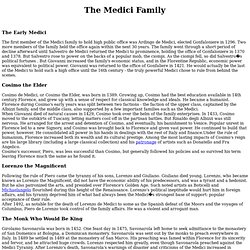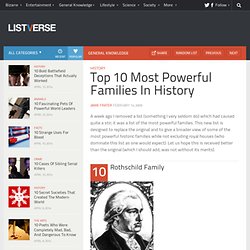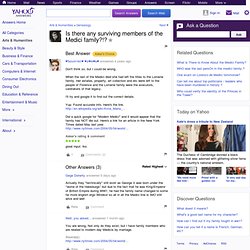

The Galileo Project. The Medici Family. The Early Medici.

Top 10 Most Powerful Families In History. History A week ago I removed a list (something I very seldom do) which had caused quite a stir; it was a list of the most powerful families.

This new list is designed to replace the original and to give a broader view of some of the most powerful historic families while not excluding royal houses (who dominate this list as one would expect). Let us hope this is received better than the original (which I should add, was not without its merits). The Rothschild family (often referred to simply as the Rothschilds), is an international banking and finance dynasty of German Jewish origin that established operations across Europe, and was ennobled by the Austrian and British governments.
The family’s rise to international prominence began with Mayer Amschel Rothschild (1744–1812 – pictured above), whose strategy for future success was to keep control of their businesses in family hands, allowing them to maintain full discretion about the size of their wealth and their business achievements. Is there any surviving members of the Medici family?! Medici, an Italian family of merchants and bankers who ruled the republic of Florence through economic power and personal influence.

By their patronage of the arts they made Florence the center of the Italian Renaissance. The Medici were created dukes of Florence by Holy Roman Emperor Charles V in 1531, and grand dukes of Tuscany by Emperor Maximilian II in 1575. The Early Renaissance - Art History Basics on the Early Italian Renaissance - ca 1400-1500. Florence, or Firenze as it's known to those who live there, was the cultural epicenter for Early Italian Renaissance art, launching the careers of many prominent artists in 15th-century Italy.

In the previous article on the Proto-Renaissance, several Republics and Duchies in northern Italy were also mentioned as artist-friendly. These places were quite serious in competing with one another for the most glorious civic adornment, among other things, which kept a lot of artists happily employed. How, then, did Florence manage to grab center stage? It all had to do with five competitions among the areas. Only one of these was specifically about art, but they were all important to art.
Competition #1: Dueling Popes. Renaissance. The Renaissance (UK /rɨˈneɪsəns/, US /ˈrɛnɨsɑːns/, French pronunciation: [ʁənɛsɑ̃s], from French: Renaissance "re-birth", Italian: Rinascimento, from rinascere "to be reborn")[1] was a cultural movement that spanned the period roughly from the 14th to the 17th century, beginning in Italy in the Late Middle Ages and later spreading to the rest of Europe.

Florence. Florence (Italian: Firenze [fiˈrɛntse] ( ), alternative obsolete form: Fiorenza; Latin: Florentia) is the capital city of the Italian region of Tuscany and of the province of Florence.

It is the most populous city in Tuscany, with approximately 370,000 inhabitants, expanding to over 1.5 million in the metropolitan area.[3] Bad blood flows as Medicis go digging up their past - World - www.smh.com.au. House of Medici. The House of Medici (/ˈmɛdɨtʃi/ MED-i-chee; Italian pronunciation: [de ˈmɛːditʃi]) was a political dynasty, banking family and later royal house that first began to gather prominence under Cosimo de' Medici in the Republic of Florence during the late 14th century.
Florence and Central Italy, 1400–1600 A.D. History of Florence - Lonely Planet Travel Information. Controversy continues over who founded Florence.

The most commonly accepted story tells us that Emperor Julius Caesar founded Florentia around 59 BC, making it a strategic garrison on the narrowest crossing of the Arno river and thus controlling the Via Flaminia linking Rome to northern Italy and Gaul (France). Why Renaissance? Why Florence? Jon Cook identifies the mix of factors that helps explain the Florentine Renaissance.

When Edmund Blackadder memorably lamented, ‘Baldrick, to you the Renaissance was just something that happened to other people’, it was probably the citizens of Florence to whom he was referring. For nowhere else were the ingredients that enabled the Renaissance to flourish – a politically-active citizenry, a vigorous humanist movement and abundant wealth – better blended. It is these ingredients, in Italy in general and in Florence in particular, that are the subject of this essay. Politics Politically, Italy was different from the rest of Europe.
In Italy, politics was a colourful and often bloody business. Humanism.